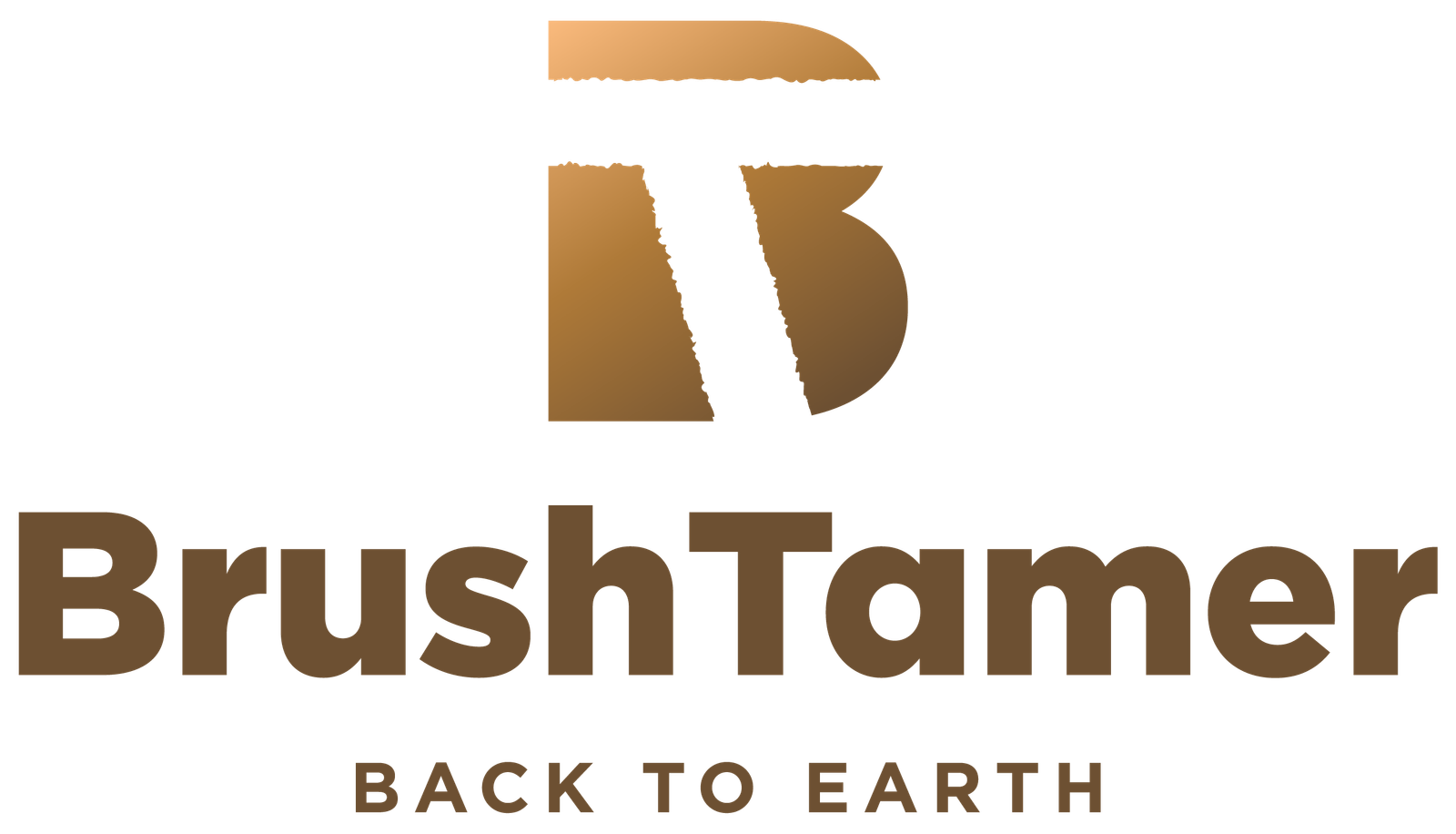Why Modern Land Clearing Equipment Makes All the Difference
Land clearing equipment has transformed how we tackle tough terrain. Whether for dense brush, large trees, or site preparation, the right machinery can reduce a weeks-long struggle to a job completed in days.
The most common types of land clearing equipment include:
- Bulldozers – Heavy-duty machines for pushing over trees and moving large debris
- Excavators – Versatile diggers that can uproot stumps and handle precise work
- Skid Steer Loaders – Compact machines perfect for tight spaces and various attachments
- Forestry Mulchers – Specialized equipment that grinds vegetation into beneficial mulch
- Compact Track Loaders – Low ground pressure machines ideal for sensitive terrain
The global land clearing equipment market is growing at 5.9% annually, reaching an expected $2.7 billion by 2030. This growth reflects increasing demand for efficient, environmentally responsible clearing methods.
Modern equipment clears faster and smarter. Forestry mulchers, for example, turn unwanted vegetation into soil-enriching mulch, eliminating the need for burning or hauling debris away. This approach prevents erosion while improving soil health.
I’m Leon Miller, owner of BrushTamer. With years of hands-on experience operating everything from compact mulchers to heavy excavators, I’ve learned that selecting the right tool for each unique terrain is the key to project success. We help property owners reclaim overgrown areas efficiently and responsibly.
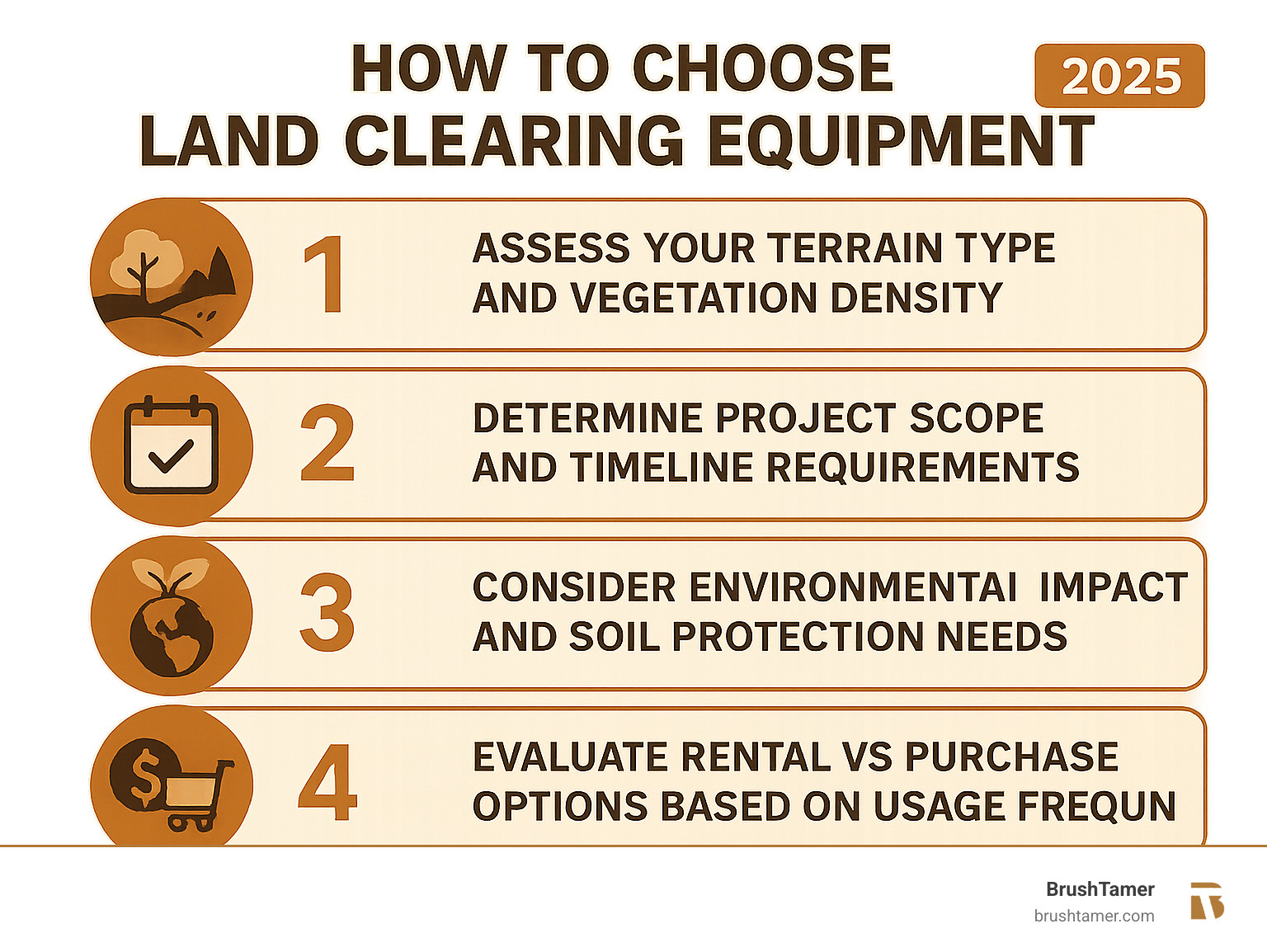
Your Guide to Core Land Clearing Equipment
At BrushTamer, we know the right land clearing equipment turns impossible jobs into manageable projects. Choosing the correct machine is how we transform dense forests into building sites and reclaim overgrown lots. Understanding these core machines is key to delivering reliable, high-quality results.
Heavy-Duty Earthmovers
When facing serious obstacles like massive trees or rocky terrain, you need machines with serious power. That’s where our heavy-duty earthmovers shine.
Bulldozers are the workhorses that tackle the biggest challenges. These powerful machines use their large front blades to push over trees, clear dense vegetation, and move enormous amounts of debris. Their raw pushing power is best against stubborn stumps or thick brush. The choice of blade is critical: a straight blade (S-blade) is ideal for fine grading, while a universal blade (U-blade) with large side wings can move massive loads of soil and debris. A combination (SU-blade) offers a compromise for general-purpose work. Furthermore, many bulldozers are equipped with a rear ripper, a claw-like device that breaks up compacted soil, rock, or pavement, preparing the ground for the front blade.
The real magic happens with specialized attachments. A root rake transforms a standard bulldozer into a precision tool for uprooting stumps while separating soil from debris. This means we can clear your land and prepare it for grading in fewer passes.
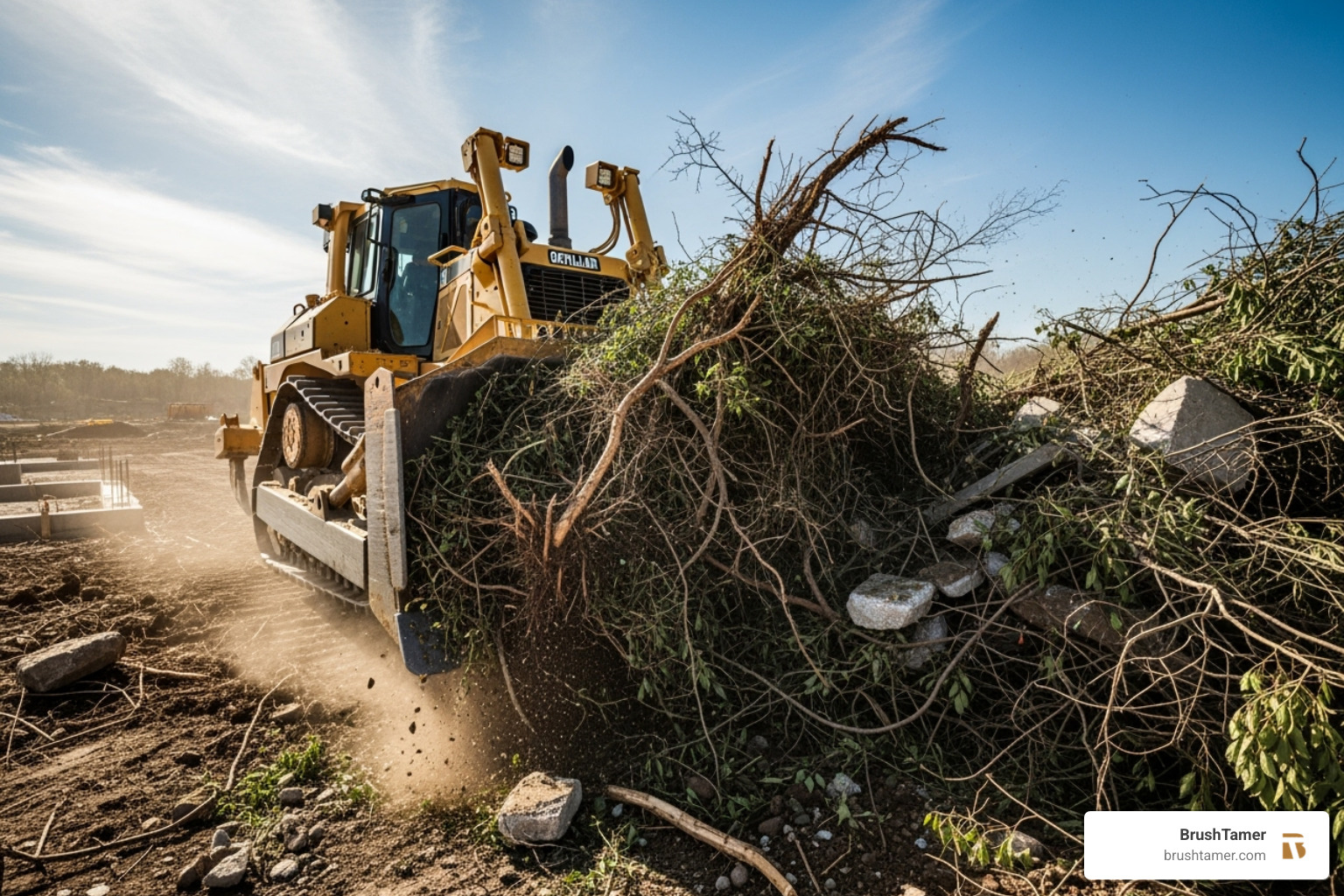
Excavators are like the Swiss Army knives of land clearing equipment. These versatile machines excel at debris removal with incredible precision, whether working around existing structures or navigating tricky terrain. Their hydraulic arms can reach into tight spots that bulldozers can’t access. Their power comes from a sophisticated hydraulic system that allows for both immense breakout force and delicate, precise movements. The 360-degree rotating cab and boom assembly means an operator can dig, lift, and place material anywhere within its reach without repositioning the entire machine, drastically improving efficiency on complex sites.
Excavators are valuable for their adaptability. On steep slopes or uneven ground where other machines struggle, they maintain their effectiveness. They excel at uprooting stumps by digging around root systems for clean extraction, which leaves soil in better condition for future use.
Versatile Loaders
For jobs requiring finesse over brute force, especially in tight spaces, versatile loaders are essential.
Skid Steer Loaders are our go-to machines for agility in tight spaces. These compact powerhouses can turn within their own footprint, making them perfect for clearing around buildings or fences. Despite their smaller size, they pack enough punch for substantial clearing tasks. It’s important to distinguish between two main types: radial lift and vertical lift. Radial lift models have an arm path that swings out in an arc, providing excellent forward reach at mid-height, which is ideal for digging and loading flatbed trucks. Vertical lift models raise the load straight up, offering better stability and lifting capacity at full height, making them superior for stacking pallets or loading high-sided dump trucks.
The key advantage of skid steers is their attachment versatility. We can switch from a mulching head to a grapple to a brush cutter in minutes, adapting one machine to whatever the job demands. This flexibility makes them incredibly efficient.
Compact Track Loaders offer low ground pressure thanks to their rubber track systems. When working on soft or wet terrain where wheeled machines might sink or cause damage, these machines glide across the surface while delivering the power needed for effective clearing. This low ground pressure is measured in pounds per square inch (PSI) and is significantly lower than that of wheeled machines, or even the human foot. This allows them to work on delicate turf, saturated soils, or sandy conditions with minimal disturbance, preserving the valuable topsoil layer and protecting the root systems of nearby trees you wish to keep.
This equipment plays a crucial role in our comprehensive approach to brush management, allowing us to maintain properties efficiently while preserving the landscape.
Specialized Vegetation Management Machines
The game-changer in modern land clearing is equipment that transforms vegetation into a beneficial resource.
Forestry Mulchers represent the pinnacle of environmentally responsible clearing. These machines perform on-site processing by cutting, grinding, and mulching vegetation in one pass. Instead of hauling away debris or burning brush piles, we turn unwanted vegetation into nutrient-rich mulch right where it stands. These machines can be purpose-built carriers or attachments for excavators and skid steers. The mulching head itself comes in different styles, primarily drum mulchers and disc mulchers. Drum mulchers use a horizontal rotating drum with fixed carbide teeth or swinging flails, excellent for grinding material finely and even processing vegetation below ground level. Disc mulchers feature a large, fast-spinning disc, similar to a giant circular saw, which excels at quickly felling standing trees and processing material above ground.
This approach delivers multiple benefits. The mulch layer provides natural soil enrichment as it decomposes, while also offering excellent erosion control. You’re not just clearing land – you’re improving it.
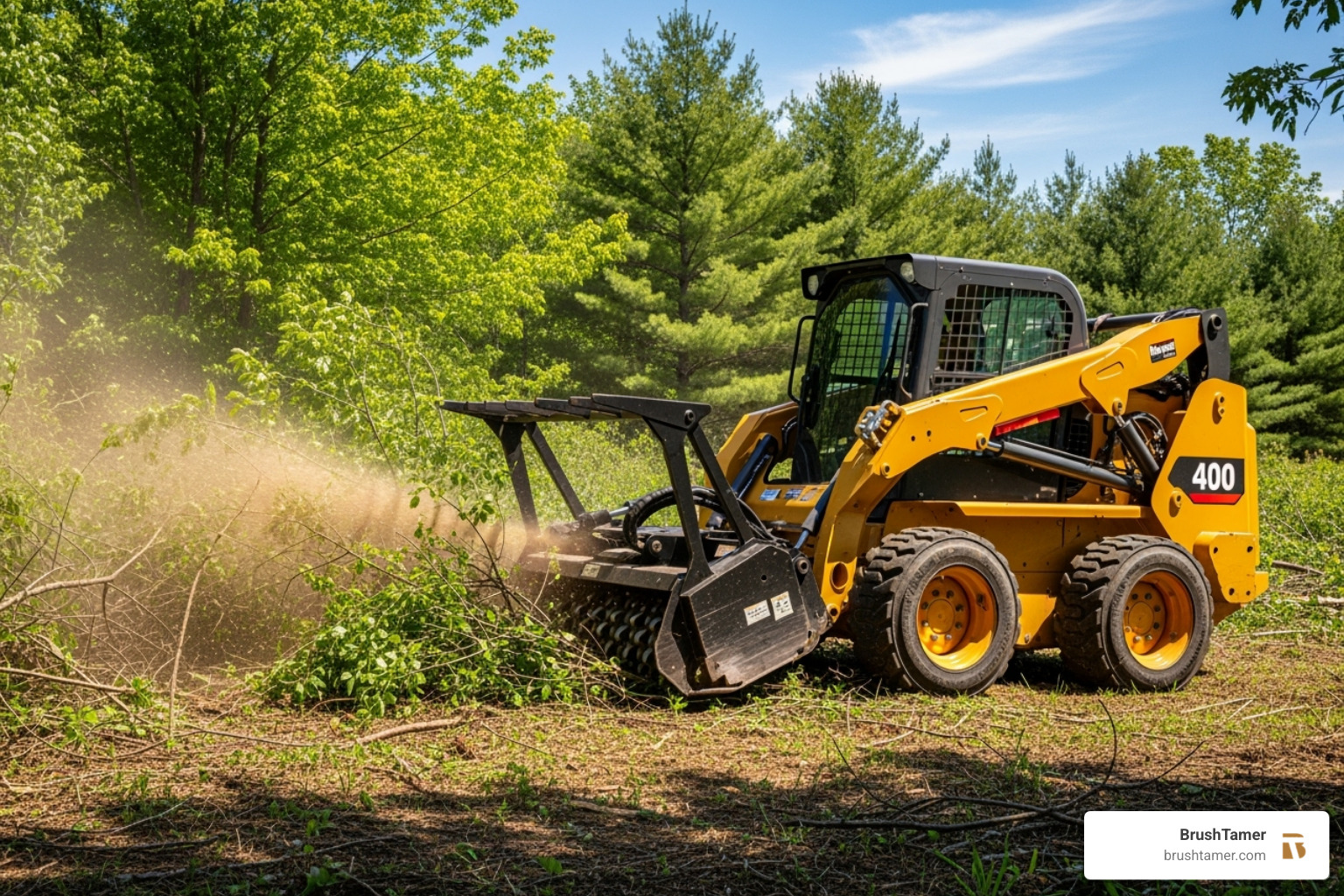
Forestry mulching is one of our most popular services because it aligns with our commitment to responsible practices. The process eliminates hauling trips and reduces the overall impact on your property. Learn more about how this innovative approach can benefit your project through our forestry mulching services.
Maximizing Versatility: Essential Land Clearing Attachments
The true power of modern land clearing equipment lies in its attachments. These tools transform a single machine into a multi-tool, increasing efficiency and capability. Swapping attachments allows us to tailor machinery to specific project demands for maximum precision and productivity.
Mulching and Grinding Attachments
These attachments are at the heart of our vegetation management services, turning unwanted growth into valuable resources.
- Forestry Mulching Heads: Designed for excavators, skid steers, and dedicated mulching tractors, these heads use sharp blades or teeth to shred vegetation into fine mulch. They are incredibly efficient for clearing dense brush and small trees, leaving behind an even layer of organic material that benefits the soil. The effectiveness of these heads depends on matching their hydraulic flow and pressure requirements (measured in gallons per minute and PSI) to the carrier machine’s output. A mismatch can lead to poor performance and potential damage to the equipment.
- Stump Grinders: After trees are felled, stump grinders come into play. These powerful attachments use a rotating cutting disc to chip away at wood, effectively removing the stump and its root systems below ground level. This makes the area ready for new landscaping or construction.
- Brushcutters: Also called brush hogs or flail mowers, these attachments are perfect for tackling dense brush, overgrown grasses, and small saplings. They are excellent for maintaining clearings, creating firebreaks, or preparing land for further development.
For more details on how we can help you with stump removal, visit More info about Stump Grinding & Removal.
Struggling and Raking Attachments
Once vegetation is cut, these attachments are crucial for efficient material handling and site preparation.
- Grapples: More efficient than buckets for irregular material, grapples allow us to grab debris, sort it, tear up roots, and load it into trucks or piles. They are indispensable for moving logs and brush, ensuring a tidy job site.
- Rakes/Root Rakes: These specialized rakes sift through soil, separating rocks, roots, and other debris from valuable topsoil. A key distinction is between a root rake, which has long, curved tines designed to penetrate the ground and pull up stubborn roots and rocks, and a landscape rake, which is used for surface finishing, spreading topsoil, and removing smaller debris to create a perfect seedbed. Root rakes are excellent for removing subsurface roots and ensuring a clean, level grade for future projects.
Shearing and Felling Attachments
For precise and efficient tree removal, specialized shearing and felling attachments are key.
- Tree Shears: These powerful hydraulic attachments cut through tree trunks quickly and cleanly. Mounted on excavators or skid steers, tree shears offer increased safety over manual felling and can significantly speed up operations, especially for trees up to 20 inches in diameter. They allow for controlled felling, reducing the risk of damage to surrounding property.
Site Preparation and Finishing Attachments
- Box Blades and Graders: For projects that require a perfectly level surface, such as for a building pad, driveway, or lawn, box blades and grader attachments are essential. Mounted on skid steers or compact tractors, they use a blade and often scarifiers (small ripper teeth) to cut high spots and fill low spots, creating a smooth, uniform grade.
- Tillers and Harrows: When preparing land for agriculture or landscaping, tiller and harrow attachments break up compacted soil, aerate it, and mix in amendments like compost. This creates an ideal growing environment, turning cleared land into productive ground.
Choosing the Right Tool: Factors for Project Success
Selecting the right land clearing equipment is about more than just power; it’s about matching the tool to the job for maximum safety, efficiency, and value. At BrushTamer, we know every property is unique. A small residential lot requires a different approach than 50 acres of dense forest, so we assess your situation before recommending an equipment strategy.
Analyzing Your Project Scope and Size
Project size dictates the equipment choice. Using the wrong machine can create unnecessary problems.
Small residential lots typically work best with compact, maneuverable equipment. A skid steer with a mulching attachment can steer tight spaces while efficiently clearing overgrown areas, minimizing disturbance to neighboring properties.
Large-scale commercial clearing demands serious horsepower. For preparing hundreds of acres, heavy-duty bulldozers and large excavators are essential. These powerhouses handle mature trees, move massive debris, and grade terrain efficiently across vast areas.
Equipment power requirements scale with project size and vegetation density. A 75-horsepower skid steer might handle light brush, but dense forest with large-diameter trees calls for specialized tracked mulchers or heavy excavators with tree shear attachments.
Before selecting equipment, we ask these critical questions:
- What is the total area to be cleared?
- What is the end goal (construction, agriculture, habitat management)?
- What is the project timeline?
- Are there access restrictions or sensitive areas?
- What nearby property or features need protection?
Evaluating Terrain and Vegetation Type
Understanding your terrain and vegetation is crucial for selecting the right equipment.
Soil conditions can make or break a project. Wet or sensitive soils require machines with low ground pressure like compact track loaders, which use rubber tracks to prevent sinking and minimize soil compaction. Firm, dry ground can accommodate heavier wheeled equipment.
Slopes and challenging topography demand stable machines with excellent traction. Some forestry mulchers are engineered to work safely on steep hillsides. Wetlands require an especially gentle touch to clear vegetation while preserving the delicate soil structure.
The vegetation type influences our approach. Light brush and grasses respond well to brushcutters or flail mowers. Dense forest with large trees requires the power of tree shears, heavy mulching heads, or traditional felling followed by stump grinding.
Tree diameter is a key decision point. Most compact mulchers handle trees up to 6-8 inches effectively, while specialized forestry mulchers can process trees up to 20 inches. Anything larger typically requires traditional felling methods.
Key Factors for Choosing Land Clearing Equipment
Several other factors can significantly impact your project’s success.
Environmental regulations are essential protections that guide equipment selection. Many areas have strict rules, such as the Clean Water Act, which protects wetlands and waterways. This goes beyond major federal laws. Local municipalities often have their own ordinances regarding tree removal (especially “heritage” trees), noise levels, and working hours. A professional service like BrushTamer will conduct due diligence to ensure all permits, such as those for stormwater pollution prevention plans (SWPPPs) required under the National Pollutant Discharge Elimination System (NPDES), are secured. In sensitive areas, this may involve coordinating with wildlife agencies to avoid disrupting nesting seasons or protected habitats. Our environmentally responsible approach involves choosing methods that minimize ecological disruption. Forestry mulching is often favored by regulators because it processes vegetation in place, preserving soil structure and eliminating debris removal.
Your debris disposal plan should drive equipment decisions. Hauling debris off-site is expensive, and burning isn’t always permitted. If mulching isn’t the primary method, a detailed logistics plan is needed. This involves separating materials: valuable timber might be sent to a sawmill, while green waste is chipped or ground for landscaping mulch or biomass fuel. For very large projects, bringing in a large-scale horizontal grinder or tub grinder can be more efficient than hauling raw debris, as it significantly reduces the volume and number of truckloads required, lowering transportation costs and emissions. Forestry mulching eliminates this challenge by converting unwanted vegetation into beneficial mulch that stays on-site, enriching the soil and preventing erosion.
Maintenance reliability is critical for meeting deadlines. Equipment breakdowns can derail project timelines. We use equipment that is rigorously maintained to ensure maximum uptime.
Operator skill level is critical. Modern equipment requires trained, experienced operators for safe and efficient work. A skilled operator does more than just move levers; they understand how to maximize the machine’s efficiency, leading to lower fuel consumption and less wear and tear. They can read the terrain and anticipate how the machine will react, preventing accidents and costly mistakes. Professional operators often hold certifications for specific equipment types and are trained in daily safety protocols, such as pre-operation walk-around inspections, which are crucial for identifying potential mechanical issues before they cause downtime. Our certified operators have the expertise to use the right machine effectively for your project.
Successful land clearing starts with a thorough assessment. By considering your project’s unique requirements, we select the perfect equipment and techniques to clear your land safely, efficiently, and responsibly.
The Smart Choice: Renting Land Clearing Equipment
For most projects, renting land clearing equipment is the smart move. It’s a flexible and cost-effective solution for property owners and contractors. At BrushTamer, we often rent equipment to ensure we have the perfect tool for each job. This approach allows us to tackle any project without the burden of owning machines that see infrequent use.
The Financials of Land Clearing Equipment: Renting
The financial benefits of renting can significantly impact your project budget.
Lower upfront capital is the biggest advantage. Instead of investing tens of thousands on heavy machinery, you free up that money for other project needs. This is especially valuable for smaller businesses or one-time projects.
Reduced maintenance costs are another key benefit. When you rent, expensive repairs and routine maintenance are the rental company’s responsibility. No more surprise breakdowns eating into your budget.
No storage concerns eliminates the need for expensive, year-round storage space for heavy equipment.
Your insurance costs also drop significantly. While you need coverage for the rental period, it’s far less expensive than insuring an owned fleet year-round.
Renting allows you to meet project-specific needs. Every clearing job is different. Renting means you get exactly the right machine for each unique challenge.
Equipment versatility becomes unlimited. Need a compact track loader this month and a forestry mulcher next? Renting provides access without the commitment of a purchase.
| Benefit Category | Description |
|---|---|
| Cost Efficiency | Lower upfront capital, no depreciation, reduced maintenance and storage costs. |
| Flexibility | Access to a diverse fleet of specialized machines and attachments for project-specific needs. |
| Modern Equipment | Use the latest models with advanced technology without the burden of ownership. |
| Reduced Risk | No long-term commitment, less financial exposure, and maintenance is handled by the rental provider. |
| Operational Ease | Focus on the project, not equipment upkeep; on-demand availability prevents delays. |
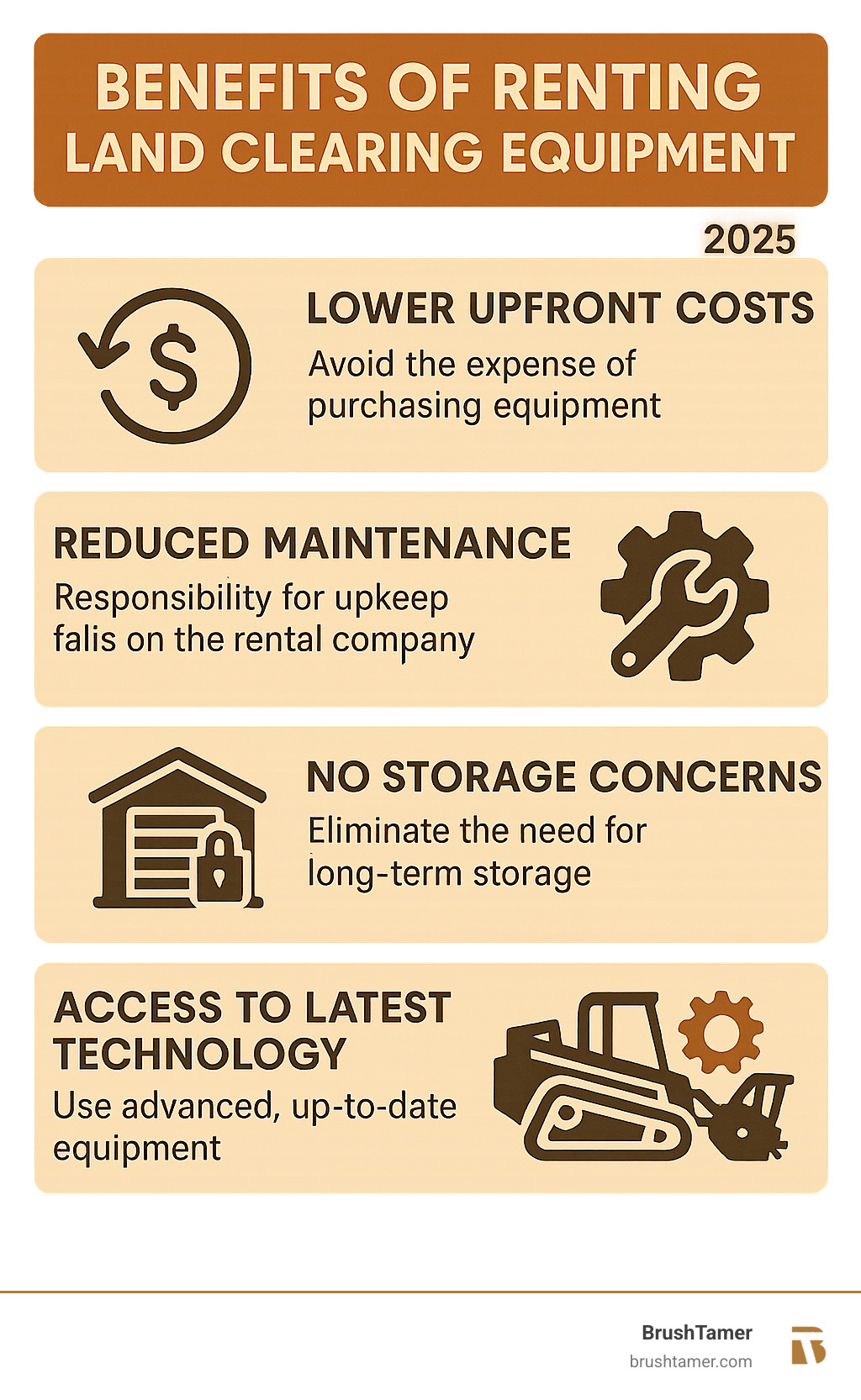
How Renting Reduces Operational Headaches
Renting also eliminates many operational headaches associated with equipment ownership.
Access to modern equipment means you’re always working with the latest technology. Rental companies regularly update their fleets, giving you access to machines with better fuel efficiency, safety features, and performance.
No long-term commitment provides incredible flexibility. As projects and needs evolve, you can adapt without being stuck with a depreciating asset.
Reduced maintenance responsibility is a major advantage of renting. You can focus on the land clearing work while the rental company handles all technical upkeep.
On-demand availability from reputable providers means the equipment is there when you need it, preventing project delays.
Selecting a Reputable Provider
Our success at BrushTamer depends on the quality of our rental equipment and partners. We’ve learned what to look for in a provider.
Equipment condition is non-negotiable. Well-maintained machines are reliable, safer, and more efficient, directly impacting project quality and timelines.
Technical support is invaluable. Access to knowledgeable experts who can help select the right equipment and troubleshoot issues is essential.
Availability is key for project continuity. We work with providers who have the specific equipment we need, when we need it.
Transparent pricing without hidden fees is essential for accurate project budgeting.
Reliability is paramount. A dependable rental provider is an extension of our commitment to quality. Their success ensures your project’s success.
Our commitment to quality and environmental responsibility extends to every partnership we make. By selecting trusted rental partners, we ensure your project is completed efficiently and to the highest standards.
Frequently Asked Questions about Land Clearing
Here are answers to common questions about land clearing, based on our years of experience in the Midwest.
What is the most versatile piece of land clearing equipment?
The most versatile piece of equipment isn’t always the biggest. Skid steer loaders and compact track loaders take the crown for versatility due to their wide range of attachment options. They are the Swiss Army knives of land clearing equipment.
Their compact size lets them work in tight spaces where larger equipment would struggle, such as around existing trees or near structures. Their quick-change attachment system allows us to swap tools in minutes, adapting from mulching to grading to debris removal.
While they can’t push over massive trees like a bulldozer, they handle the majority of clearing tasks with impressive efficiency.
How does forestry mulching benefit the environment?
Forestry mulching is a cornerstone of our responsible, efficient land clearing approach at BrushTamer. It eliminates the need for burning vegetation (which causes air pollution) or hauling debris to landfills.
The mulch layer left behind prevents soil erosion, especially on slopes, and retains moisture in the soil. As it breaks down, it returns nutrients to the soil naturally, acting as a vitamin boost. The mulch also suppresses weed growth, creating a natural barrier against invasive plants.
Crucially, forestry mulching causes minimal soil disturbance. Unlike bulldozers that scrape and compact the ground, mulching equipment operates with a light touch, preserving the delicate topsoil ecosystem. We can also practice selective mulching, clearing unwanted underbrush while protecting valuable mature trees.
Can I clear land with dense, large-diameter trees?
Yes, but it requires the right approach and heavy-duty equipment. Every dense forest project requires a professional assessment first. We evaluate tree size, species, density, and terrain before recommending the best equipment combination.
For massive trees or extremely dense forests, we use bulldozers to push over large trees and large excavators with specialized attachments to cut and remove them. These machines can handle root systems that smaller equipment cannot.
Forestry mulchers are fantastic for trees up to about 8 inches in diameter, but for larger trees, you need equipment that matches their strength and size. The key is matching the machine to the challenge. Our client-focused approach begins with understanding your specific situation to ensure we recommend the safest and most efficient methods and equipment.
Conclusion
Choosing the right land clearing equipment is straightforward once you understand what each machine does. From bulldozers that reshape landscapes to compact mulchers that turn brush into soil-enriching nutrients, every machine serves a specific purpose.
Success comes down to three elements: choosing the right equipment, prioritizing safety, and maintaining environmental responsibility. Analyzing your terrain, vegetation, and the financial benefits of renting land clearing equipment sets your project up for success.
The efficiency of modern land clearing lies in methods like forestry mulching, which can transform overgrown properties while improving the soil. It’s a win-win approach that saves time, money, and protects the environment.
At BrushTamer, we’ve seen how the right equipment and approach lead to smooth, efficient operations. Our expertise across the Midwest – from South Bend, Indiana to Chicago, Illinois, and throughout Ohio and Michigan – has taught us that every property requires a custom solution.
Whether you’re preparing land for construction, reclaiming an overgrown property, or managing vegetation, the right equipment makes all the difference. However, experienced professionals who can effectively operate that equipment are what make a project exceptional.
Ready to see what modern land clearing equipment can do for your property? Get a professional assessment for your Land Clearing project and find how we can help you achieve your land management goals efficiently and responsibly.
